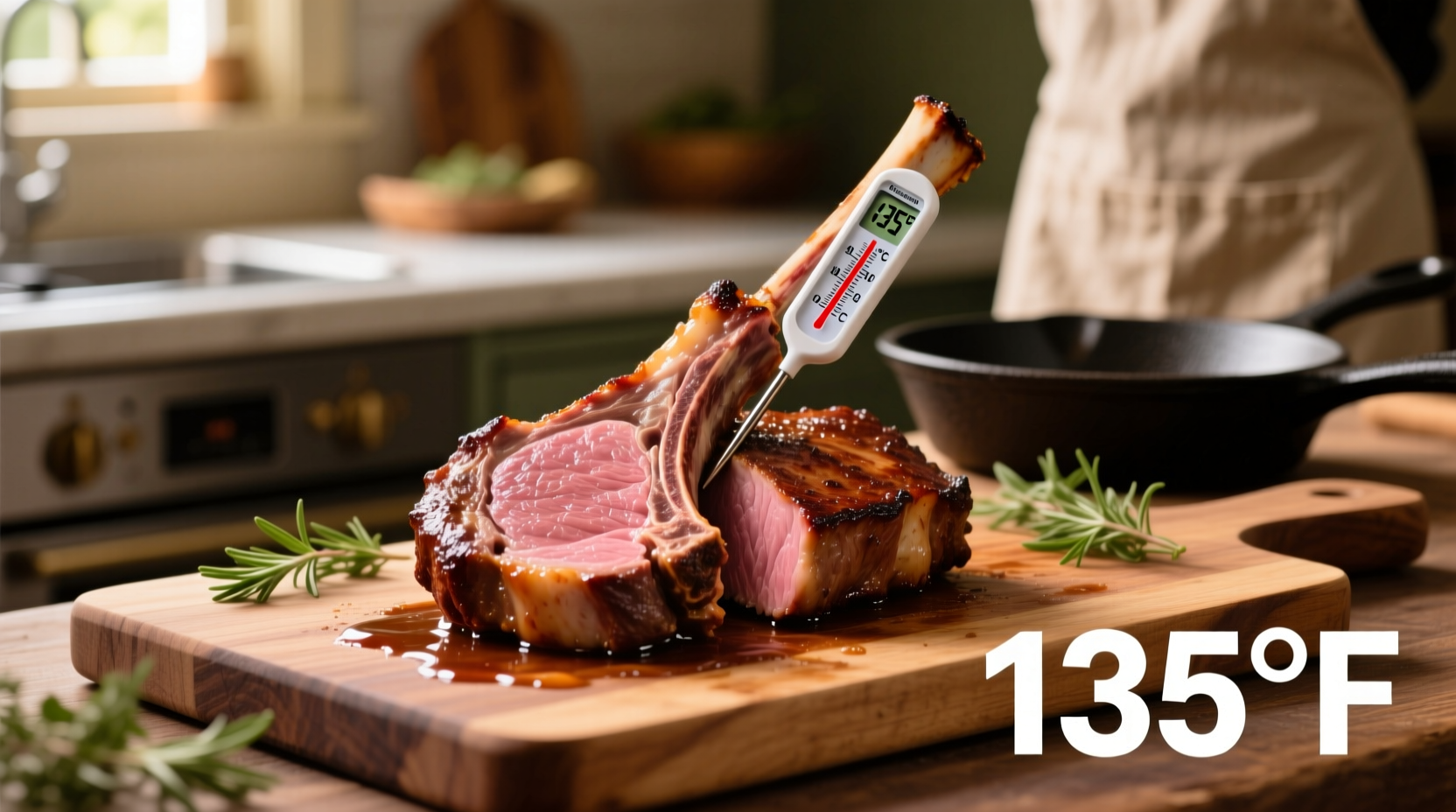Why Temperature Precision Matters for Perfect Lamb
Getting the temperature right when cooking lamb isn't just about preference—it's a critical factor in food safety, texture, and flavor development. Unlike poultry, lamb contains less connective tissue and benefits from precise temperature control to achieve that perfect balance between safety and succulence.
When you cook lamb, the proteins begin to denature at around 105°F (40°C), gradually firming as temperature increases. The myoglobin (which gives meat its red color) starts breaking down between 140-150°F (60-66°C), explaining the color change from red to pink to brown. Understanding these scientific principles helps you achieve consistent results every time.
The Complete Lamb Temperature Reference Guide
Here's the definitive temperature guide for cooking lamb to your preferred doneness level:
| Doneness Level | Internal Temperature | Visual Characteristics | Resting Time |
|---|---|---|---|
| Rare | 120-125°F (49-52°C) | Bright red center, very soft to touch | 5-10 minutes |
| Medium-rare (Recommended) | 130-135°F (54-57°C) | Warm red center, soft with slight resistance | 10-15 minutes |
| Medium | 140-145°F (60-63°C) | Pink center, firm but yielding | 10-15 minutes |
| Medium-well | 150-155°F (66-68°C) | Slightly pink center, fairly firm | 10-15 minutes |
| Well-done | 160°F+ (71°C+) | Little to no pink, very firm | 10-15 minutes |
| Ground Lamb | 160°F (71°C) | No pink remaining throughout | 5 minutes |
According to the USDA Food Safety and Inspection Service, 145°F (63°C) is the minimum safe internal temperature for whole cuts of lamb, measured with a food thermometer in the thickest part of the meat, not touching bone. This temperature, followed by a 3-minute rest period, destroys harmful bacteria while preserving optimal texture and juiciness.
How to Accurately Measure Lamb Temperature
Proper temperature measurement is crucial for perfect results. Follow these professional techniques:
- Use the right thermometer: Digital instant-read thermometers provide the most accurate readings for lamb. Leave-in probe thermometers work well for roasts.
- Insert correctly: Place the thermometer tip in the geometric center of the thickest part of the meat, avoiding fat, bone, or gristle.
- Check multiple spots: Especially with irregular cuts like shoulder, check several areas to ensure even cooking.
- Wait for stabilization: Keep the thermometer in place until the reading stops climbing for an accurate measurement.
A common mistake home cooks make is checking temperature too early or too frequently, which allows heat to escape and extends cooking time. For best results, check only when you're reasonably certain the lamb is near your target temperature.

Cooking Methods and Temperature Adjustments
Different cooking techniques require slight temperature adjustments to account for heat distribution and cooking speed:
Oven Roasting
For larger cuts like leg of lamb or shoulder, roast at 325°F (163°C) until reaching 5-10°F below your target temperature, then let carryover cooking finish the job during resting. The American Culinary Federation recommends removing lamb from the oven when it reaches 125°F (52°C) for medium-rare, as it will continue to rise to 135°F (57°C) during the 10-15 minute rest period.
Grilling
When grilling lamb chops or racks, use a two-zone fire. Sear over direct high heat, then move to indirect heat to finish cooking to your target temperature. The National Steak and Beef Association notes that lamb grilled over charcoal typically requires 3-5°F lower target temperatures than oven-roasted lamb due to more intense surface heat.
Sous Vide
For precision cooking, set your water bath to your exact desired final temperature (e.g., 130°F/54°C for medium-rare), then finish with a quick sear. This method eliminates guesswork and ensures perfect edge-to-edge doneness.
The Critical Importance of Resting Time
Resting isn't optional—it's essential for juicy, flavorful lamb. During cooking, juices migrate toward the surface. Resting allows these juices to redistribute throughout the meat. The carryover cooking effect means lamb continues to cook 5-15°F after removal from heat, depending on the cut's size.
Research from the Culinary Institute of America shows that properly rested lamb retains up to 40% more moisture than lamb sliced immediately after cooking. For chops, rest 5-10 minutes; for larger roasts, rest 15-20 minutes, loosely tented with foil.
Special Considerations for Different Lamb Cuts
Not all lamb cuts should be cooked to the same temperature:
- Leg of lamb: Best at medium-rare (130-135°F/54-57°C) for optimal tenderness
- Rack of lamb: Ideal at medium-rare (130-135°F/54-57°C) to maintain pink center
- Lamb chops: Shoulder chops benefit from higher temperatures (145°F/63°C), while loin chops are best medium-rare
- Ground lamb: Must reach 160°F (71°C) for food safety
- Lamb shanks: Should be cooked to 195-205°F (90-96°C) for proper braising
The Food Safety.gov emphasizes that ground lamb requires higher temperatures because the grinding process distributes potential bacteria throughout the meat, unlike whole cuts where bacteria are primarily on the surface.
Troubleshooting Common Temperature Issues
Even experienced cooks encounter temperature challenges. Here's how to handle common issues:
If Your Lamb Is Undercooked
If you've removed lamb too early, return it to gentle heat (oven at 250°F/121°C or indirect grill) until it reaches target temperature. Check every 3-5 minutes to avoid overcooking. For thin cuts like chops, sear briefly on both sides before returning to indirect heat.
If Your Lamb Is Overcooked
While prevention is best, overcooked lamb can be salvaged:
- Slice very thinly against the grain
- Serve with a flavorful sauce or jus
- Shred for use in tacos, sandwiches, or salads
- Moisten with a compound butter
Temperature Fluctuations During Cooking
Opening the oven or grill frequently causes temperature swings. Professional chefs recommend limiting oven door openings and using a probe thermometer with remote monitoring to maintain consistent cooking environment.











 浙公网安备
33010002000092号
浙公网安备
33010002000092号 浙B2-20120091-4
浙B2-20120091-4